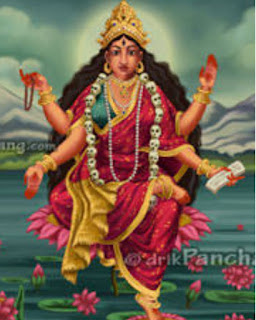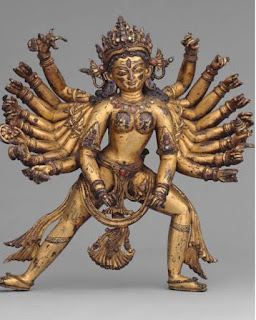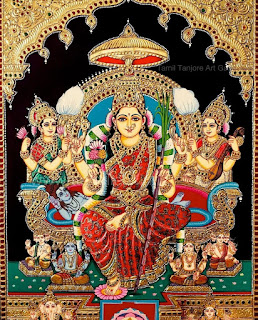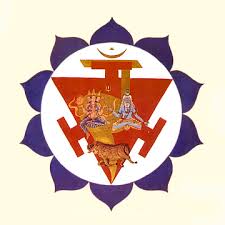भानु-मण्डल-मध्यस्ता (275)
Bhānu-maṇḍala-madhyastā
She is in the middle of solar orbit. Anāhat cakra is also called bhānu-maṇḍala and kuṇḍalinī also glitters like gold. Possibly, this nāma could mean Her kuṇḍalinī form.
भैरवी (276)
Bhairavī
Wife of Bhairavā (Śiva) is Bhairavī. They are inseparable.
A girl of twelve years is also called as Bhairavī.
भगमालिनी (277)
Bhagamālinī
Bhaga has many meanings. Goddess Savitṛī is also addressed as Bhaga. It also means good fortune, happiness, welfare, prosperity, dignity, majesty, distinction, excellence, beauty, loveliness, etc.
She is in the form of Bhagamālinī, one of the tithi nitya devi-s.
पद्मासना (278)
Padmāsanā
She is seated on a lotus or She is sitting in the posture of padmāsana (a yogic way of sitting, cross legged). Padma means lotus. When one is seated in padmāsana, the posture will appear like a lotus.
भगवती (279)
Bhagavatī
Bhaga refers to six qualities of Śaktī viz. supremacy, righteousness, fame, prosperity, wisdom and discrimination. As one who's endowed with all these qualities, she's called as Bhagavathi
पद्मनाभ-सहोदरी (280)
Padmanābha-sahodarī
She is the younger sister of Lord Viṣṇu.
उन्मेष-निमिषोत्पन्न-विपन्न-भुवनावली (281)
Unmeṣa-nimiṣotpanna-vipanna-bhuvanānavalī
Unmeṣa means opening eye lids and nimiṣ means closing of eye lids. The creation and dissolution of the universe happens at the wink of Her eyes. When She opens Her eyes, universe is created and when She closes Her eyes, universe is dissolved (vipanna).
सहस्र-शीर्ष-वदना (282)
Sahasra-śīrṣa-vadanā
Sahasra in this context means infinite and literally means thousand. She has countless heads and faces.
सहस्राक्षी (283)
Sahasrākṣī
She has thousands of eyes.
सहस्रपात्(284)
Sahasrapād
She has thousands of feet.
आब्रह्म-कीट-जननी (285)
Ābrahma-kīṭa-jananī
The Supreme creator, She creates from Brahma to the smallest insect.
वर्णाश्रम-विधायिनी (286)
Varṇāśrama-vidhāyinī
Varṇāśrama means the order of life as expounded in Vedās. Veda-s classify people based upon their knowledge and capabilities. As creator of the Vedas, she is the one who has expounded the order of life.
निजाज्ञा-रूप-निगमा (287)
Nijājñā-rūpa-nigamā
Namas 287 and 288 deal with karma kanda of the Vedas.
She conveys Her commands through Veda-s.
पुण्यापुण्य-फलप्रदा (288)
Puṇyāpuṇya-phalapradā
Puṇyāpuṇya consist of two words puṇya + a-puṇya. Puṇya means the good or right, virtue, purity, good work, meritorious act, moral or religious merit, and a-puṇya means the illusionary puṇya. Results arising out of such actions are transferred to one’s karmic account at Her command as She is the Lord of karma-s.
श्रुति-सीमन्त-सिन्दूरी-कृत-पादाब्ज-धूलिका (289).
Śruti-sīmanta-sindūrī-kṛta-pādābja-dhūlikā
Veda-s are considered as the most sacred texts of all. In this nāma the four Veda-s are personified as goddesses. Lalithambika is so Supreme as the absolute Brahman that these Goddesses are satisfied by wearing the dust in Her feet in their parting hair and get satisfied that they are at least able to wear the dust that gives them some knowledge (the knowledge of the Brahman) about Her.
सकलागम-संदोह-शुक्ति-संपुट-मौक्तिका (290)
Sakalāgama-saṃdoha-śukti-saṃpuṭa-mauktikā
This nāma says that the great scriptures of Veda-s and agama śāstra-s are enclosed within the tiny piece of Her nose ring made of pearl.
पुरुषार्थ-प्रदा (291)
Puruṣārtha-pradā
Puruṣārtha is the fourfold values of human life. They are dharma (righteousness or virtues), artha (wish or purpose), kāma (desires and pleasures) and mokṣa (the liberation). She is the giver of this puruṣārtha.
पूर्णा (292)
Pūrṇā
She is the perfect (without blemishes) totality of everything.
भोगिनी (293)
Bhoginī
Bhoga means luxuries. She is the enjoyer of all luxuries.
भुवनेश्वरी (294)
Bhuvaneśvarī
Bhuvana means the universe. She is the ruler (Īśvari) of this universe.
अम्बिका (295)
Ambikā
The mother of the universe.
अनादि-निधना (296)
Anādi-nidhanā
She has neither a beginning nor an end. The nature of the Brahman is described, who alone is infinite.
हरिब्रहमेन्द्र-सेविता (297)
Haribrahamendra-sevitā
Hari (Viṣṇu), Brahma and Indra worship Her. In Śrī cakra pūja, Hari, Brahma and Indra are all worshipped.
नारायणी (298)
Nārāyaṇī
The creations made out of the Brahman are known as Narani and the abode of Narani is called Narayana. The feminine gender of Nārāyaṇa is Nārāyaṇī. This nāma also reconfirms Her Brahmanic status.
नाद-रूपा (299)
Nāda-rūpā
She is in the form of sound
नाम-रूप-विवर्जिता (300)
Nāma-rūpa-vivarjitā
She is without name (nāma) and form (rūpa). Vivarjitā means devoid. She is beyond names and forms, an exclusive quality of the Brahman.
ह्रींकारी (301)
Hrīṁkārī
She is in the form of māyā bīja hrīṁ. Hrīṁ is also called śākta praṇava or śaktī praṇava, which means that the worshippers of śaktī, call hrīṁ as praṇava bīja of Śaktī. This is also known as Bhuvaneśvarī bījā . Praṇava is the supreme ॐ. The power of hrīṁ bīja is as powerful as ॐ.
ह्रीमती (302)
Hrīmatī
Hrī means modesty. Veda-s describe Her as endowment of modesty, mind, satisfaction, desire and nourishment.
हृद्या (303)
Hṛdyā
She resides in the heart. Soul is said to be in the centre of the heart. Heart also stands for compassion and love. Since She is the Divine Mother, these qualities are in built in Her.
हेयोपादेय-वर्जिता (304)
Heyopādeya-varjitā
She has nothing to reject and nothing to accept. Rejections and acceptances are applicable only to human beings and not to the Brahman.
राजराजार्चिता (305)
Rājarājārchitā
She is worshipped by king of kings and emperors.
राज्ञी (306)
Rājñī
The queen. She's the queen of Lord Shiva, the Lord or all kings
रम्या (307)
Ramyā
She is the most beautiful of all.
राजीवलोचना (308)
Rājivalochanā
Rājiva means deer, fish or lotus, depending upon the context and locanā means eyes. Eyes of Mā look like the eyes of deer or appear like a fish or look like a lotus flower.
रञ्जनी (309)
Rañjanī
Rañjana means the act of colouring and also pleasing, charming, rejoicing, delighting, befriending, etc. As Ranjani, She gives happiness to Her devotees .
रमणी (310)
Ramaṇī
She plays around. She plays with Her devotees. Devotees are everything for Her. She gives happiness to them and She plays with them too.
रस्या (311)
Rasyā
She is in the form of essence of Ātman, which is to be identified with sweetness. Rasa means Sweet.
रणत्किङ्किणि-मेखला (312)
Raṇatkiṅkiṇi-mekhalā
She is wearing a waistband with small bells hanging from it.
When She walks, these tiny bells make tinkling sound from where the sound originates. The sound originates from the naval chakra, where the waist belt is worn.
रमा (313)
Ramā
Ramā means Lakṣmī, the goddess of wealth. She is in the form of Lakṣmī and bestows wealth on Her devotees.
राकेन्दुवदना (314)
Rākenduvadanā
Her face is compared to the full moon.
रतिरूपा (315)
Ratirūpā
She is in the form of Rati, the wife of love god Manmatha .
रतिप्रिया (316)
Ratipriyā
She is fond of Rati, the wife of Kāma. There is a yakṣiṇī (lower form of demigoddess) called Ratipriyā who gives wealth. She is said to be Kubera’s wife.
रक्षाकरी (317)
Rakṣākarī
She's the one who protects the universe.
राक्षसघ्नी (318)
Rākṣasaghnī
The destroyer of demons.
रामा (319)
Rāmā
She is the embodiment of women.
रमण-लम्पटा (320)
Ramaṇa-lampaṭā
She enjoys Her moments with Her consort Śiva at sahasrāra. She enjoys the marital bliss. She loves to play around with Śiva.
काम्या (321)
Kāmyā
Kāmyā means longing for. She is desired by the seekers of liberation.
कामकला रूपा (322)
Kāmakalā rūpā
She is in the form of kāmakalā. This is Her subtler form which is known only to Her spouse Śiva. The subtlest form is Her kuṇḍalinī form in sahasrāra, where She conjoins Her spouse.
Kāma means intent to create and kalā refers to a part of the main object, in this case, Śiva. The conjugation of Kāma and kalā leads to the manifestation of Kāmeśvara and Kāmeśvarī forms.
कदम्ब-कुसुम-प्रिया (323)
Kadamba-kusuma-priyā
She is fond of kadamba flowers, amidst the tress of which She lives.
There are said to be five types of sacred trees and kadamba tree is one among them. These five sacred trees said to represent the four components of antaḥkaraṇa viz. mind, intellect, consciousness and ego and the fifth being the heart where the soul is said to reside .
The smell of these flowers is compared to the modifications of the mind.
कल्याणी (324)
Kalyāṇī
She is the embodiment of auspiciousness.
जगती -कन्दा (325)
Jagatī -kandā
She is the cause of the universe. The cause for the origin of the universe is attributed to the Brahman.
करुणारस-सागरा (326)
Karuṇārasa-sāgarā
The ocean of compassion. Karuṇa means compassion, rasa means essence and sāgara means ocean.
कलावती (327)
Kalāvatī
She is the possessor of these sixty four types of arts.
कलालापा (328)
Kalālāpā
Her speech itself is an art. Kalā generally means sixty four types of fine arts. kala refers melodious voice. Ālāpa also means speech. This nāma refers to Her melodious voice as art or Kalā.
कान्ता (329)
Kāntā
She is beautiful, vibrating and radiant.
कादम्बरी-प्रिया (330)
Kādambarī-priyā
Kādambara is spirituous liquor distilled from the flowers of the Kadamba. The Supreme Goddesses is known for Her liking of it.
वरदा (331)
Varadā
The one who grants boons.
वाम-नयना (332)
Vāma-nayanā
Literally this nāma means ‘beautiful eyes’. Vāma also means fruits of action and nayat means leading to. Vāma-nayanā therefore means ‘the fruits of one’s actions lead to Her’, indicating the final liberation.
वारुणी-मद-विह्वला (333)
Vāruṇi-mada-vihvalā
Vāruṇi is the extract of dates that is allowed to brew and when consumed causes inebriation. By consuming this, She forgets the surroundings and concentrates on Her inner Self (possibly meaning Śiva) is the literal meaning of this nāma.
There is a nāḍi (nerve) called vāruṇi which can be controlled by breath. This nāḍi plays a significant role in excretion of bodily waste. If this nāḍi is brought under control by proper breathing exercises, one will never feel tiredness in the body. Sages keep this nāḍi under their control to cope up with longer duration of meditation. She is said to be in form of this nāḍi.
विश्वाधिका (334)
Viśvādhikā
There are thirty six important tattvas which include basic five elements, four components of antaḥkaraṇa (ego, intellect, mind and memory) seven components of māyā tattva and five components of Śiva tattva. She transcends all these tattvas.
वेद-वेद्या (335)
Veda-vedyā
She can be known through Veda-s. All the Veda-s lead to the Supreme Reality, the Brahman.
विन्ध्याचल-निवासिनी (336)
Vindhyācala-nivāsinī
She lives in Vindhyā mountains.
विधात्री(337)
Vidhātrī
Dhātrī means the motherhood. She being (Śrī Mātā) the Supreme Mother, She nourishes this universe.
वेद-जननी (338)
Veda-jananī
Creator of Veda-s.
विष्णु-माया (339)
Viṣhṇu-māyā
She's the illusory power of Vishnu
विलासिनी (340)
Vilāsinī
Vilāsa means playful. This could mean Her liking for playing with her devotees. Also with Her consort Shiva.
With this nama, ends the description of Her Pancha Brahma swaroopam.































